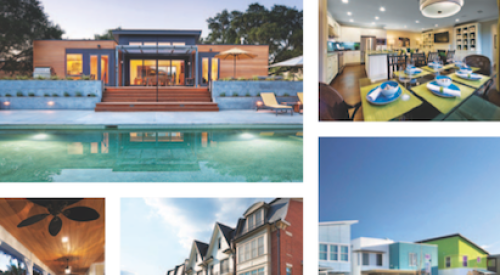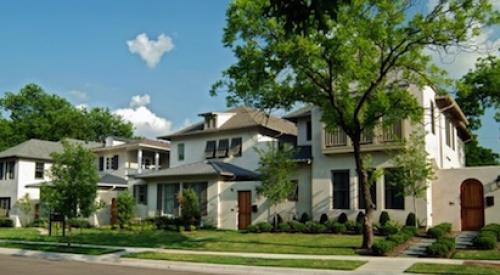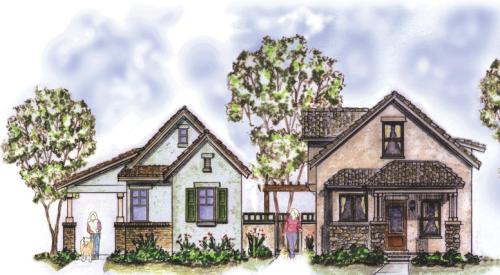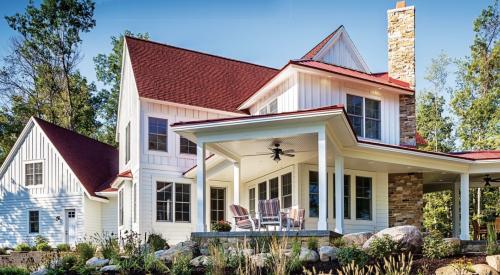 |
Architectural ensembles appeal because the whole is greater than the sum of the parts. Ensembles can be unusually profitable as well. Although Rosewalk's cottages were the least expensive to build in 1982 at $57/sf (including land costs), by 1992 they sold for $340/sf — a 600% increase over ten years and an average of $125/sf more than other Seaside homes. Today, the value of the cottages has escalated to $1,666/sf. |
 |
 |
 |
ROSEWALK These cottages at Seaside, built as part of an ensemble neighborhood on six of the community's least desirable lots, now command the highest per square foot resale price in the development. |
 |
 |
CREATING CONNECTIONS The site plan for the Rosewalk neighborhood at Seaside shows how each cottage turns inward to create a neighborhood feel around the gardens. |
The buildings in an architectural ensemble are like the instruments in a musical ensemble, sounding together to create a compelling whole. The harmonious outcome is more important than any individual part. The conscientious arrangement of buildings in concert with cars and landscape elements creates more than a place: it creates a world unto itself.
Well-planned ensembles are not only a good community investment — today's top ensembles are tomorrow's historic districts — they can be a smart financial investment as well.
Rosewalk
In the early 1980s, my former partner and I designed the Rosewalk ensemble for the widely recognized cottage community of Seaside, FL. We converted six of Seaside's least desirable lots into fourteen of its most valuable homes, all part of an ensemble that includes gardens, gazebos, and garden follies.
Although Rosewalk's cottages were inexpensive to build in 1982 at $57 per square foot (including land costs), by 1992 they sold for $340 per square foot — a 600% increase over ten years and an average of $125 per square foot more than other Seaside homes. Today, the value of the cottages has escalated to $1,666 per square foot. To the delight of its residents, Rosewalk has attracted widespread media coverage, including appearances on national television.
A successful architectural ensemble addresses three considerations:
1) The volume of the central space
2) The strategic positioning of the structures that define the spaces contours, and
3) The character of all elements within the ensemble.
The central space is primary because ensembles are most readily distinguished by their emphasis on a unifying space, be it a street, garden, or courtyard. It may come as a surprise to some that the space, more than the buildings, adds the greatest value. The width of this space has to be in a viscerally "correct" proportion to the height and the length. People instantly know when they enter a well-proportioned space: it feels as welcoming as slipping into a warm bathtub on a winter's eve.
Equal in importance to the unifying space is the positioning of structures that define the edge and through-ways of the ensemble, giving it shape and dimension. Walls, fences, and buildings may be strategically positioned to obstruct views of less pleasant scenery, or their arrangement may gesture toward a grand vista. A well-positioned porch gently buffers the natural terrain. Stairs and towers invite the imagination to soar. Paths lead you to unseen destinations, while arcades and overhanging balconies add a friendly element, promising shelter from rain and sun.
Last but not least, the ensemble gains character from its architectural facades. Although the spaces within ensembles may derive inspiration from anywhere in the world, they are more believable if the facades are familiar faces with a pronounced regional flavor. You sense character and authenticity in a building that is related to its location, for a region's architectural vernacular is shaped by local climate and available materials.
Architectural ensembles are accentuated by gardens, pools, walls, gates, seats, gazebos, and follies, all of which are fundamental to the spirit and character of the ensemble. They must be thoughtfully placed where people will use them, not like the forbiddingly vacant roadside entrance areas of gated suburban neighborhoods, isolated beside the road to signal drive-bys. If you put seats and gazebos where people will use them, they will become more than set pieces, giving life to the community when in use and suggesting human habitation even when empty. Be careful to give these structures just the right amount of sun, shade, and privacy.
Ensembles can take the form of a small town center with generous civic sprit, a cluster of dollhouse-like cottages, or a colony of artists' studios and galleries. The buildings and shared spaces of ensembles can hold many functions: as shops, offices, town centers, and residential courtyards, to name a few.
Cottage Ensembles
Of particular interest to me is the cottage ensemble because of its intimate feel and diminutive charms. Whether designed to feel like the romantic paradises of Hope Town or Harbour Island in the Bahamas, like the charming Oak Bluffs at Martha's Vineyard, or like "Sconset" at Nantucket, cottage ensembles completely captivate.
The examples here all have a maritime theme. There are other cottage ensembles inspired by the places people love most: Italian hill towns, turn of the century retreats and camps, even 1920's theme villages or 1950's motor courts.
An architectural ensemble can be a complete project unto itself, or it can be a means of seeding a larger venture. The ensemble approach can generate such high real estate values that it is a strategy worth considering when starting a project.
Architectural ensembles have many advantages over conventional suburban neighborhoods. Because ensembles are inward looking, they can be used to deal with undesirable edge conditions, possibly neutralizing real estate liabilities or even turning them into assets. If you can't simply remove the train tracks or the drab shopping plaza, best to build a community that turns a cold shoulder to those undesirable things and a warm face to a pleasant street, courtyard, or garden.
The intimate feeling of ensembles and the secure sense of being inside a nearly perfect place seem to beguile the home buyer. The particularly magical quality of cottage ensembles transports many visitors beyond the expected. Whether you are interested in building communities of cottages or houses, the ensemble is ideal for those who seek to maximize land use and profits while providing an optimally appealing environment.












